In the field of artificial intelligence, there is a noteworthy area of research that centers around ethical and moral considerations in various domains, and one prominent example is the concept of “deepfakes.” Deepfakes have opened up a new dimension within artificial intelligence, where they can create metahuman or AI avatars capable of mimicking human actions, speech, and gestures.
But what if we harnessed deepfake technology to instantly enhance common educational practices, such as creating presentations? What would that look like? I recently had the opportunity to explore a generative AI web-based application called “Deep Brain AI,” which expands the horizons of AI capabilities, particularly in the realm of content creation. What does this mean in practical terms? Users can develop PowerPoint presentations, just like they always have, to convey information to an audience. However, the intriguing twist is that a full body animated AI avatars or metahumans can replace human speakers. Consequently, the presenter doesn’t need to speak, as the AI avatar or metahuman can handle the task.
The web-based application allows you to create templates, insert text boxes, and upload videos and audio, just like a standard PowerPoint application. The real innovation emerges when you can create an AI avatar, either male or female, with the ability to speak in various languages and accents from different countries. For instance, you can choose between accents like U.S. English, Indian English, Saudi Arabian Arabic, Taiwanese Chinese, and German from Germany. The AI avatar can articulate the content through a text script, effectively enabling text-to-speech input.
The application offers a range of features, including control over scene speed and the ability to insert additional pauses. What’s even more fascinating is the incorporation of advanced generative AI technologies, such as ChatGPT, into the application. I found this particularly intriguing, as it recognizes the utility of ChatGPT and integrates it seamlessly into the platform.
However, there were some shortcomings when using the application, most notably the unnatural quality of the deepfake avatars. They were easily discernible as artificial, which could lead to dissatisfaction among users and their audiences when listening to the AI avatars or reading the presentations.
Nonetheless, the age of artificial intelligence is advancing at an unprecedented pace, and my overall experience with the application has been positive. I’m keen to hear about your experiences with Deep Brain AI or deepfake technology in general.



Dear Julian, that’s an interesting blog post! It stroke my interest since most news on deepfakes are rather negative, but you just highlighted some ways to use deepfakes for a positive purpose. What immediately came to my mind, was to use these deepfakes on aircrafts. Since airlines have a very high amount of international customers, it could be hard for them to tune in with customer needs. There are often two or three languages used for announcements and explanation documents. For people from different continents this could rise high barriers in understanding the information, which could cause some problems, especially when it comes to safety. Implementing deepfakes for explaining the safety measures in their own language could make it possible to transfer information more easily.